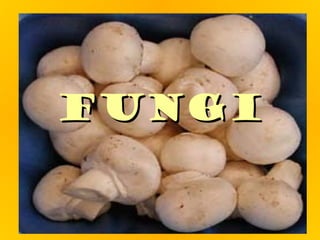
Fungi
- 1. Fungi
- 2. How are cheese, bread, and soy sauce related to fungi? A fungus can help make each of these foods!
- 3. Fungi (singular form is fungus) are everywhere Mushrooms on pizza are a type of fungus Yeast used to make bread is a fungus
- 4. If you’ve ever had athlete’s foot, you can thank a fungus for that, too!
- 5. Characteristics of Fungi Fungi: eukaryotic heterotrophs that have rigid cell walls and no chlorophyll Food for Fungi – Cannot catch or surround food – Must live on or near food supply – Most are consumers—get nutrients by secreting digestive juices onto a food source and then absorbing dissolved food
- 6. – Many are decomposers— feed on dead plant or animal matter – Some fungi live in mutualism with other organisms Example: many types of fungi grow on or in roots of plants and help the roots absorb minerals while the plant provides nutrients to the fungus This relationship between a plant and a fungus is called a mycorrihiza
- 7. Hidden From View – Many-celled fungi are made up of chains of cells called hyphae – Hyphae: threadlike fungal filaments that are made up of cells that have openings in their cell walls These openings allow cytoplasm to move freely between the cells – Most of the hyphae that make up a fungus grow together to form a twisted mass called the mycelium
- 9. Making More Fungi – Reproduction is asexual or sexual – ASEXUAL: occurs in 2 ways: (1) hyphae break apart and each new piece makes a new fungus or (2) spores spread by wind and grow where they land – SEXUAL: special structures form sex cells and join to produce sexual spores that grow into a new fungus
- 10. This puffball is releasing sexual spores that can produce new fungi.
- 11. Kinds of Fungi Fungi classified based on shape and the way that they reproduce Four main groups of fungi: – (1) threadlike fungi – (2) sac fungi – (3) club fungi – (4) imperfect fungi
- 12. Threadlike Fungi – Mold: a fungus that looks like wool or cotton – Most of these fungi live in the soil and are decomposers – Some are parasites – Reproduce asexually—hyphae grow into the air and form round spore cases (sporangia), which break open and release spores into air
- 13. YEAST Sac Fungi – Largest group of fungi – Includes yeast, powdery mildews, truffles, and morels – Reproduce sexually and asexually during their life cycles (when sexually, they form sac called ascus) MORELS
- 14. Side Note on Truffles Truffles are difficult to find and very expensive as a result! In 1994, black truffles sold for $350 to $500 a pound. In the United States, edible truffles are collected in the forests of Oregon and Washington. In Europe, most truffles are collected in France and Italy. Truffle hunters in Italy and France use pigs and mixed- breed dogs to sniff out truffles. Dogs are preferred to pigs because pigs love to eat truffles. Notice the staff held by the truffle hunter in the picture with the pig. The hunter uses the staff to force the pig to back off, once the pig has located a truffle
- 15. -Yeast are single celled and reproduce by budding
- 16. –yeast used to make bread and alcohol yeasts use sugar as food and produce carbon dioxide gas and alcohol as waste. Trapped bubbles of CO2 cause bread dough to rise. – Useful to humans – Other sac fungi are sources of antibiotics and vitamins
- 17. Club Fungi – Umbrella-shaped and most familiar – Example: mushrooms – Reproduce sexually— special hyphae grow clublike structures called basidia, where spores develop – In gill fungi, the basidia of these mushrooms develop into structures called gills, under the mushroom cap
- 18. – Mushrooms usually grow at the edges of the mass of hyphae underground—this is why mushrooms often appear in circles – A ring of mushrooms can appear overnight. In European folk legends, these were known as “fairy rings”
- 19. BRACKET FUNGI Nonmushroom Fungi – Mushrooms are not the only club fungi – Also includes: bracket fungi, puffballs, smuts, and rusts – Smuts and rusts are common plant parasites CORN SMUT
- 20. Imperfect Fungi – Includes all of the species of fungi that do not quite fit into other groups – Do not reproduce sexually – Most are parasites that cause diseases in plants and animals – Example: athlete’s foot (a skin disease)
- 21. – Some are useful penicillum, which is the source of antibiotic penicillin
- 22. Lichens – Combinations of a fungus and an alga that grow together – Alga actually lives inside the protective walls of the fungus – Result of mutualistic relationship BRITISH SOLDIER LICHEN CHRISTMAS LICHEN
- 23. –Unlike fungi, lichens are producers—algae in lichen produce food through photosynthesis –Because lichens need only light, air, and minerals to grow, they can grow on rocks –Lichens make acids that break down rocks and cause cracks –Lichens absorb water and minerals from air easily affected by air pollution